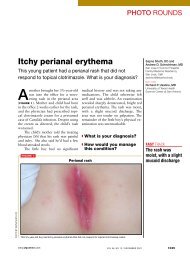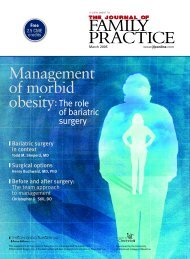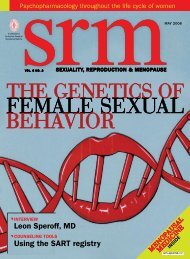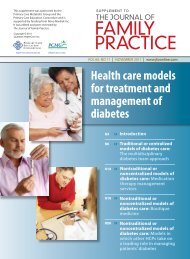Download the PDF - The Journal of Family Practice
Download the PDF - The Journal of Family Practice
Download the PDF - The Journal of Family Practice
You also want an ePaper? Increase the reach of your titles
YUMPU automatically turns print PDFs into web optimized ePapers that Google loves.
JFP_0306_AE_Power.final 2/15/06 3:45 PM Page 194<br />
APPLIED EVIDENCE<br />
FAST TRACK<br />
TABLE 1<br />
Instrument delivery<br />
increased risk<br />
<strong>of</strong> anal injury<br />
2- to 7-fold;<br />
vacuum-assisted<br />
delivery should<br />
be used when<br />
circumstances<br />
allow<br />
Classification <strong>of</strong> perineal injury 9<br />
INJURY DEFINITION<br />
First degree Injury confined to vaginal mucosa<br />
Second degree Injury <strong>of</strong> vaginal mucosa and perineal muscles,<br />
but not <strong>the</strong> anal sphincter<br />
Third degree Injury to <strong>the</strong> perineum involving <strong>the</strong> anal<br />
sphincter complex (external and internal)<br />
3a 50% <strong>of</strong> external sphincter thickness is torn<br />
3c Internal sphincter is torn<br />
Fourth degree Injury to external and internal sphincter<br />
and rectal mucosa/anal epi<strong>the</strong>lium<br />
fourth-degree lacerations varies widely; it<br />
is reported at between 0.5% and 3.0% in<br />
Europe and between 5.85% and 8.9% in<br />
<strong>the</strong> US. 2,4–6 A landmark British paper from<br />
1993 revealed that though only 3% had a<br />
clinical third- or fourth-degree perineal laceration,<br />
35% <strong>of</strong> primiparous women<br />
(none <strong>of</strong> whom had any defect before<br />
delivery) had ultrasound evidence <strong>of</strong> varying<br />
degrees <strong>of</strong> anal sphincter defect at<br />
6 weeks postpartum that persisted at 6<br />
months. 2 However, only about a third <strong>of</strong><br />
<strong>the</strong>se women had symptoms <strong>of</strong> bowel<br />
disturbance during <strong>the</strong> time <strong>of</strong> study.<br />
<strong>The</strong>se findings are supported by a<br />
meta-analysis in which 70% <strong>of</strong> women<br />
with a documented obstetric anal sphincter<br />
injury were asymptomatic. 7 This metaanalysis<br />
concluded that clinical or occult<br />
obstetric anal sphincter injury occurs in<br />
27% <strong>of</strong> primigravid women, and in 8.5%<br />
<strong>of</strong> multiparous women.<br />
<strong>The</strong> long-term significance <strong>of</strong> occult<br />
obstetric anal sphincter injury and any<br />
relationship with geriatric fecal incontinence<br />
is unknown, although 71% <strong>of</strong> a<br />
sample <strong>of</strong> women with late-onset fecal<br />
incontinence were found to have ultrasound<br />
evidence <strong>of</strong> an anal sphincter defect<br />
thought to have occurred at a previous<br />
vaginal delivery. 8 A recent English study 9<br />
reveals that when women were carefully<br />
re-examined after delivery by a skilled<br />
194 VOL 55, NO 3 / MARCH 2006 THE JOURNAL OF FAMILY PRACTICE<br />
obstetrician looking specifically at <strong>the</strong> anal<br />
sphincter, <strong>the</strong> prevalence <strong>of</strong> clinically diagnosed<br />
third-degree lacerations rose sharply<br />
from <strong>the</strong> 11% initially diagnosed by <strong>the</strong><br />
delivering physician or midwife to 24.5%.<br />
A subsequent endoanal ultrasound detected<br />
only an additional 1.2% (3 injuries, 2 <strong>of</strong><br />
which were in <strong>the</strong> internal anal sphincter<br />
and <strong>the</strong>refore clinically undetectable). This<br />
strongly suggests that <strong>the</strong> vast majority <strong>of</strong><br />
obstetric anal sphincter injuries can be<br />
detected clinically by a careful exam and<br />
that, when this is done, true occult injuries<br />
will be a rare finding.<br />
■ Mechanisms <strong>of</strong> injury<br />
Maintenance <strong>of</strong> fecal continence involves<br />
<strong>the</strong> coordinated action <strong>of</strong> several anatomical<br />
and physiological elements (FIGURE<br />
1). 10 An intact, innervated anal sphincter<br />
complex (both external and internal) is<br />
necessary. <strong>The</strong> sphincter complex can be<br />
damaged during childbirth in 3 ways.<br />
Direct mechanical injury. Direct external<br />
or internal anal sphincter muscle<br />
disruption can occur, as with a clinically<br />
obvious third- or fourth-degree perineal<br />
laceration or an occult injury subsequently<br />
noted on ultrasound.<br />
Neurologic injury. Neuropathy <strong>of</strong> <strong>the</strong><br />
pudendal nerve may result from forceps<br />
delivery or persistent nerve compression<br />
from <strong>the</strong> fetal head. 14 Traction neuropathy<br />
may also occur with fetal macrosomia and<br />
with prolonged pushing during Stage 2 in<br />
successive pregnancies, or with prolonged<br />
stretching <strong>of</strong> <strong>the</strong> nerve due to persistent<br />
poor postpartum pelvic floor tone. Injured<br />
nerves <strong>of</strong>ten undergo demyelination but<br />
usually recover with time.<br />
Combined mechanical and neurologic<br />
trauma. Isolated neurologic injury, as<br />
described above, is believed to be rare.<br />
Neuropathy more commonly accompanies<br />
mechanical damage. 15<br />
■ Who is at risk?<br />
Several risk factors are unavoidable. One<br />
<strong>of</strong> <strong>the</strong>se is primiparity, a consistently









